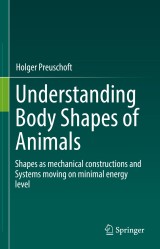Details

Understanding Body Shapes of Animals
Shapes as mechanical constructions and Systems moving on minimal energy level|
171,19 € |
|
| Verlag: | Springer |
| Format: | |
| Veröffentl.: | 28.06.2022 |
| ISBN/EAN: | 9783030276683 |
| Sprache: | englisch |
| Anzahl Seiten: | 581 |
Dieses eBook enthält ein Wasserzeichen.
Beschreibungen
<p>This book discusses how and why animals evolved into particular shapes. The book identifies the physical laws which decide over the evolutionary (selective) value of body shape and morphological characters. Comparing the mechanical necessities with morphological details, the author attempts to understand how evolution works, and which sorts of limitations are set by selection.</p><p>The book explains morphological traits in more biomechanical detail without getting lost in physics, or in methods. Most emphasis is placed on the proximate question, namely the identification of the mechanical stresses which must be sustained by the respective body parts, when they move the body or its parts against resistance.</p>In the first part of the book the focus is on ‘primitive’ animals and later on the emphasis shifts to highly specialized mammals. Readers will learn more about living and fossil animals.<p></p><p>A section of the book is dedicated to human evolution but not to produce anotherevolutionary tree, nor to refine a former one, but to contribute to answering the question: “WHY early humans have developed their particular body shape".</p>
Chapter1: Why this book?.- Chapter2: Head.- Chapter3: Axial skeleton in aquatic animals.- Chapter4: Axial skeleton and muscle arrangement in terrestrial tetrapods.- Chapter5: What have the extremities of “lower tetrapods” in common? And Why?.- Chapter6: Birds.- Chapter7: Land-living mammals.- Chapter8: Primates, the group including humans.- Chapter9: Evolution of hominids.- Chapter10: Summary, Conclusions and Open questions.
<div>Prof. Dr. Holger Preuschoft is an Emeritus Professor at the Center for Anatomy, Ruhr-Universität in Bochum, Germany. 13 years back he was awarded the title "Docteur honoris causa" by the Université Louis Pasteur in Strasbourg, France. He has published more than 196 papers, and edited 9 multi-author books over the course of his career. </div><div><div><br></div></div>
<p>This book discusses how and why animals evolved into particular shapes. The book identifies the physical laws which decide over the evolutionary (selective) value of body shape and morphological characters. Comparing the mechanical necessities with morphological details, the author attempts to understand how evolution works, and which sorts of limitations are set by selection.</p><p>The book explains morphological traits in more biomechanical detail without getting lost in physics, or in methods. Most emphasis is placed on the proximate question, namely the identification of the mechanical stresses which must be sustained by the respective body parts, when they move the body or its parts against resistance.</p>In the first part of the book the focus is on ‘primitive’ animals and later on the emphasis shifts to highly specialized mammals. Readers will learn more about living and fossil animals.<p></p><p>A section of the book is dedicated to human evolution but not to produce anotherevolutionary tree, nor to refine a former one, but to contribute to answering the question: “WHY early humans have developed their particular body shape".</p>
Simplifies a complicated picture of why a particular shape has evolved into its current form Provides an interdisciplinary approach that integrates mechanics into biology, anatomy and paleontology Presents zoological, primatological and anthropological aspects of functional morphology
<div><div>Simplifies a complicated picture of why a particular shape has evolved into its current form<br></div><div><br></div><div>Provides an interdisciplinary approach that integrates mechanics into biology, anatomy and paleontology</div><div><br></div><div>Passes on knowledge of zoological, primatological and anthropological aspects of functional morphology gathered by the author for more than half a century</div><div><br></div></div><div><div><br></div></div><div><br></div>

















